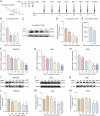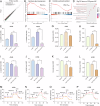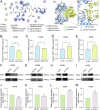Downregulation of tRNA methyltransferase FTSJ1 by PM2.5 promotes glycolysis and malignancy of NSCLC via facilitating PGK1 expression and translation
- PMID: 39695074
- PMCID: PMC11655989
- DOI: 10.1038/s41419-024-07287-0
Downregulation of tRNA methyltransferase FTSJ1 by PM2.5 promotes glycolysis and malignancy of NSCLC via facilitating PGK1 expression and translation
Abstract
Fine particulate matter (PM2.5) exposure has been associated with increased incidence and mortality of lung cancer. However, the molecular mechanisms underlying PM2.5 carcinogenicity remain incompletely understood. Here, we identified that PM2.5 suppressed the expression of tRNA methyltransferase FTSJ1 and Am modification level of tRNA in vitro and in vivo. FTSJ1 downregulation enhanced glycolytic metabolism of non-small cell lung cancer (NSCLC) cells, as indicated by increased levels of lactate, pyruvate, and extracellular acidification rate (ECAR). Whereas treatment with glycolytic inhibitor 2-DG reversed this effect. In contrast, upregulation of FTSJ1 significantly suppressed glycolysis of NSCLC cells. Mechanistically, the silencing of FTSJ1 increased NSCLC cell proliferation and glycolysis through enhancing the expression and translation of PGK1. In human NSCLC tumor samples, FTSJ1 expression was negatively correlated with PGK1 expression level and the SUVmax value of PET/CT scan. In summary, our work reveals a previously unrecognized function of PM2.5-downregulated FTSJ1 on PGK1-mediated glycolysis in NSCLC, suggesting that targeted upregulation of FTSJ1 may represent a potential therapeutic strategy for NSCLC.
© 2024. The Author(s).
Conflict of interest statement
Competing interests: The authors declare no competing interests. Ethics approval and consent to participate: All methods were performed in accordance with the relevant guidelines and regulations. Studies using human samples were approved by the Medical Ethics Committee of Shenzhen University (Approved no. 2016002) and informed, written consents were obtained from all study subjects. All animal experiments were carried out following the procedures approved by the Institutional Animal Care and Use Committee of Shenzhen University Medical School (Approval No. IACUC-202300059).
Figures







References
-
- Lim SS, Vos T, Flaxman AD, Danaei G, Shibuya K, Adair-Rohani H, et al. A comparative risk assessment of burden of disease and injury attributable to 67 risk factors and risk factor clusters in 21 regions, 1990-2010: a systematic analysis for the Global Burden of Disease Study 2010. Lancet. 2012;380:2224–60. - PMC - PubMed
-
- Samek L, Furman L, Mikrut M, Regiel-Futyra A, Macyk W, Stochel G, et al. Chemical composition of submicron and fine particulate matter collected in Krakow, Poland. Consequences for the APARIC project. Chemosphere. 2017;187:430–9. - PubMed
-
- Javed W, Iakovides M, Stephanou EG, Wolfson JM, Koutrakis P, Guo B. Concentrations of aliphatic and polycyclic aromatic hydrocarbons in ambient PM2.5 and PM10 particulates in Doha, Qatar. J Air Waste Manag Assoc. 2019;69:162–77. - PubMed
MeSH terms
Substances
Grants and funding
- 41977372/National Natural Science Foundation of China (National Science Foundation of China)
- JCYJ20190806154210829/Shenzhen Science and Technology Innovation Commission
- 20231121155815200/Shenzhen Science and Technology Innovation Commission
- JCYJ20220531102612029/Shenzhen Science and Technology Innovation Commission
- 2022A1515012033, 2024A1515012760/Natural Science Foundation of Guangdong Province (Guangdong Natural Science Foundation)
LinkOut - more resources
Full Text Sources
Medical
Miscellaneous

